The manual mitre boxes of the 1960s have significantly been replaced by the mitre saws of today. A mitre saw is an indispensable tool for anyone who performs any kind of carpentry work. Since trim work necessitates so many cuts at an angle, mitre saws are commonly referred to as “trim saws.”
Mitering is the process of fitting two boards together at an angle. Nevertheless, they come in handy for various crosscuts, including angle cutting on roof rafters and end cuts on hardwood flooring strips.
A woodworker or carpenter’s projects determine the best miter saws to use. Read on to find out more about this crucial woodworking tool and what we discovered during our hands-on testing of the following models.
Top 10 Best Miter Saw:
Depending on specific metering requirements, one of these high-end saws might be a helpful addition to the workshop, even if not everyone will require the most powerful saw or the advanced capabilities of sliding compound mitre saws.
Additionally, we conducted in-person testing with the following models to ensure we’re only recommending the best miter saw.
Our Recommendations Best Miter Saw in 2023
| Image | Product | Details | Price |
|---|---|---|---|
 |
BOSCH GCM12SD 15 Amp 12 Inch Corded Dual-Bevel Sliding Glide | Mitres and bevels in both directions. The system for collecting dust is highly efficient. Expensive |
Check Price |
 |
DEWALT 12″ DWS715 Miter Saw- best budget miter saw | Movable compared to sliding mitre saws Strongly designed. Bevels only to the left. |
Check Price |
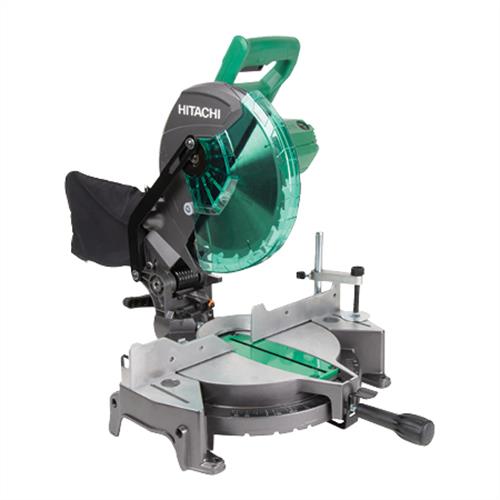 |
Metabo HTP C10FCGS 10″ Compound Miter Saw | Even hobbyists will find it affordable. Strong 15-amp motor Five-year warranty, lightweight and portable |
Check Price |
 |
Makita LS1040 10″ Compound Miter Saw- best quality | Accurate and strongly constructed Relatively lightweight |
Check Price |
 |
CRAFTSMAN V20 7-1/4-Inch Sliding Miter Saw Kit – best cordless | Both the left and right bevels Long-lasting battery Mechanism for positioning LED cut lines |
Check Price |
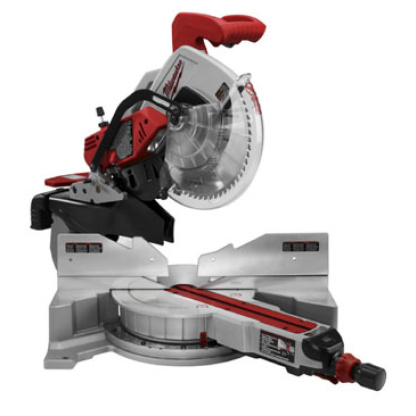 |
Milwaukee 6955-20 12″ Sliding Dual Bevel Miter Saw – Best for trim | Amazingly precise bevel and mitre cut controls Handles longboards and trim pieces with ease Both left and right bevels |
Check Price |
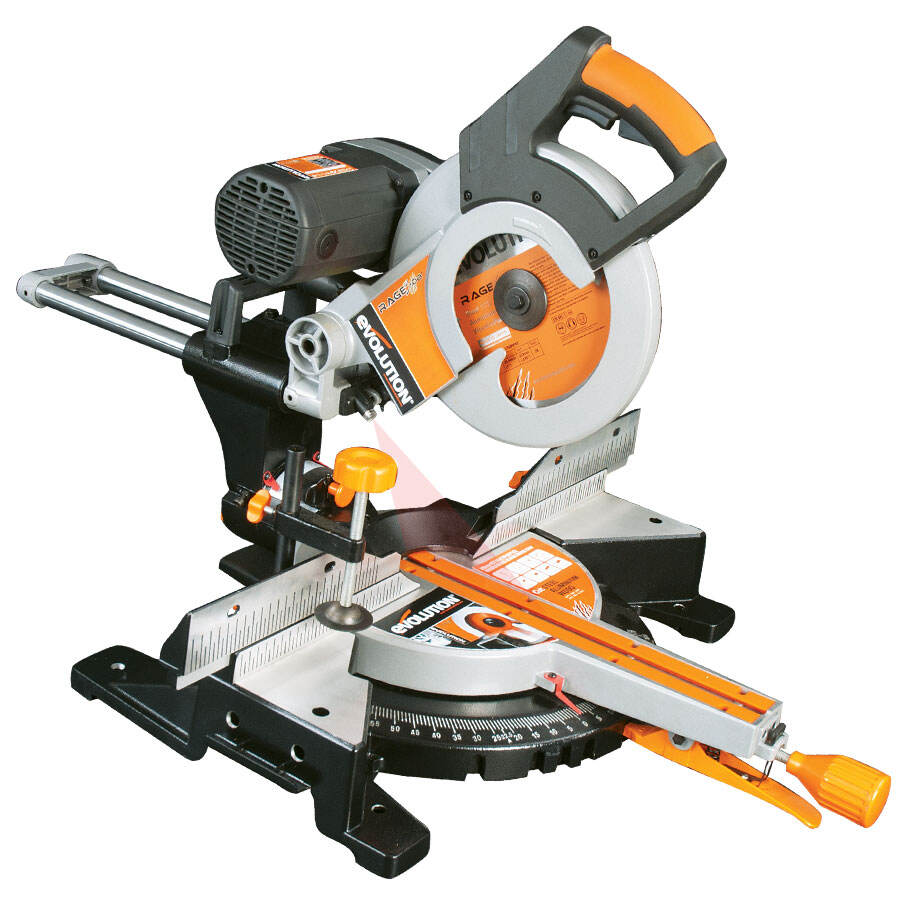 |
Best All-Rounder: Evolution 3-DB Compound Mitre Saw | Cutting depth stop is easily adjustable. Several accessories are included. A three-year warranty is included. |
Check Price |
1) BOSCH GCM12SD 15 Amp 12 Inch Corded Dual-Bevel Sliding Glide – Best Overall:

With the movable arm included with the Bosch Power Tools GCM12SD 12-inch miter saw, users may cut boards up to 14 inches wide. The saw can steady boards up to 40 inches long and can cut compound angles in both directions. It also comes with pull-out material supports on both sides.
The Bosch miter saw’s clear saw guard is made to not block the user’s vision of the cut at any point throughout the cutting operation.
Both right-handed and left-handed users can operate the trigger handle with equal comfort because of its comfortable grip and padded nonslip surface. The mitre scale numbers are engraved into stainless steel for durability, and the fences are adjustable.
Testing revealed that the Bosch saw genuinely deserves the top spot on this list. It has a zero-clearance slide arm that may, if necessary, rest up against a wall.
The arm is also relatively smooth, allowing for precise cutting. Additionally, no assembly was required, and numerous additional references for the roof rafters and valley cuts were built in. The motor is quite powerful, and the dust collection is amazing.
The main drawbacks of this saw are that it is a bit heavy to move around the shop and lacks any lasers or lights.
2) DEWALT 12″ DWS715 Miter Saw- best budget miter saw:

It is not unexpected that DEWALT has two products on our list as it is one of the leaders in the power tool industry.
The DWS715 is a powerful 12-inch mitre saw with a 15-amp motor that can cut through materials up to five inches thick and eight inches broad.
It’s a strong mitre saw all around, but it costs more than some of its closest rivals without providing as many standout features. However, DEWALT is known for making strong tools with the excellent build quality.
You get a tall fence with the DWS715 that is excellent for cutting heavier materials. For bevelled cuts, the fence even slides out of the way. However, unlike the Metabo saw in the spot before this DEWALT, the blade only bevels to the left.
Also, this saw lacks a laser light for cutting alignment. The DEWALT weighs somewhat more than 40 pounds, though. Although DEWALT’s three-year guarantee isn’t the finest in the business, it’s still much better than nothing.
3) Metabo HTP C10FCGS 10″ Compound Miter Saw – Best Value:

Power tools can be costly, and mitre saws are on the larger, more expensive end of the spectrum. However, with the Metabo HTP C10FCGS, you can get an excellent mitre saw at a very low cost.
It has a smaller 10-inch blade that can’t cut through larger lumber, but it’s a great choice for anything 2×6 and smaller. With a powerful 15-amp motor, it has enough power to cut through anything that the blade can reach. If you change out the blade, it can even cut through metals.
One issue we noticed with many of the premium 12-inch mitre saws was their weight and bulk. You wouldn’t want to move them all the time.
That’s fine for a saw that will spend its entire life in a workshop, but if you ever need to move outside of your workspace for a project, the smaller size and lighter weight of the Metabo C10FCGS will be a lifesaver.
Despite being smaller and less expensive than much of the competition, the five-year warranty should provide peace of mind. All of this adds up to the best mitre saw for the money, in our opinion.
If you only intend to use a mitre saw occasionally, or for a single large project such as redoing flooring, building furniture, or cutting trim, there’s no need to spend much money on it. Consider the Metabo HPT—the new name for Hitachi is C10FCGS 10-Inch Compound Miter Saw.
4) Makita LS1040 10″ Compound Miter Saw- best quality:

With a direct-drive engine that won’t slow things down or slip even when the going gets rough, this 10-inch, 15-amp compound mitre saw handles crosscuts, rip cuts, bevels, and mitres with ease.
The maximum speed of this saw is 4,600 rpm, and electronic speed control maintains the speed even when it is fully loaded.
This is an excellent tool for many large-scale woodworking tasks, such as framing and creating decks or cabinets. It’s a well-made, reliable, accurate mitre saw that does the job without a lot of frills.
The saw can make a maximum cut of 5.1 inches at a 90-degree angle and 3.6 inches at a 45-degree angle. With this saw, you can cut a 4×4 in one pass up to the maximum cutting thickness of 4 inches, but larger timber will need two passes.
For bevel cuts up to 45 degrees, the saw can only be adjusted to the left. Maximum mitre cuts to the left are 45 degrees, and maximum cuts to the right are 52 degrees. It weighs only 24 pounds, which is a plus if you plan to transport it to job sites rather than keep it in your workshop.
5) CRAFTSMAN V20 7-1/4-Inch Sliding Miter Saw Kit – best cordless

The Craftsman CMCS714M1 Cordless 7-1/4-Inch Miter Saw offers plenty of power and versatility in a more compact design.
While most mitre saws are corded tools with larger blades, if you want to be free of the power cord tether, plan on using the saw for smaller materials, such as baseboards, crown mouldings, crafts, or similar projects; this model is ideal.
This sliding mitre saw is powered by a 20-volt battery and has a cutting capacity of 8 inches at 90 degrees and 5-1/2 inches at 45 degrees. It also incorporates a method for placing LED cut lines for increased accuracy.
Bevels and mitres can be cut up to 47 degrees in either the left or right direction. When used at a 90-degree angle, the tool has a maximum cutting depth of 8 inches and a maximum cutting depth of 5.5 inches.
The manufacturer claims this saw can cut up to 585 pieces of 3-1/4-inch MDF baseboard on a single charge. It can go as fast as 3,800 rpm. The battery and charger are part of the kit.
6) Milwaukee 6955-20 12″ Sliding Dual Bevel Miter Saw – Best for trim:

A dual bevel is necessary when cutting trim, baseboards, siding, and other panels to provide precise cuts on both ends of the material.
The greatest option for such a project would be a sliding dual-bevel blade because baseboards and other trim are sometimes long lengths of wood. In addition to the dual-bevel blade, the Milwaukee 12-Inch Dual-Bevel Sliding Saw has a number of useful features that make cutting trim, baseboards, and similar things quick and easy.
For wider cuts, the carbide blade has a diameter of 12 inches. The blade moves back and forth on the sliding arm when even greater width is needed.
This blade is a great option for folks who want more apparent bevels in their woodcuts because it has a dual-bevel cutter that can cut angles up to 48 degrees in either direction.
One of the most powerful motors on the market, the 15-amp motor can produce up to 3.3 horsepower and cut through denser materials.
7) Best All-Rounder: Evolution 3-DB Compound Mitre Saw

The Evolution Power Tools 3-DB is a top-rated compound mitre saw that can be used on-site or at home (110V/220V). According to the manufacturer, it can cut a variety of materials, including mild steel, nonferrous metals, wood, plastic, and many others.
This miter saw has a double bevel facility for making multiple matching cuts for pieces such as crown moldings. This eliminates the need to re-adjust the workpiece and allows for much faster cutting.
Several distinctive features immediately drew our attention. The first was the inline D-shaped handle instead of the common sideways-oriented handles. Inside the handle are two triggers: one for turning on and off the motor and one for safety with two functions.
Depressing the safety switch deactivates the guard lock, allowing the blade guard to open. The safety switch also allows the saw head to be lowered towards the material to be cut. Both triggers work well and require little effort to use. It’s worth noting that the blade guard is made of metal and covers the blade when the saw head is in the up position.
This design exposes no saw blade teeth when the saw is not in use. Because this saw has a soft start motor, there is a second-for-two delay when the trigger for the motor is depressed. While some people dislike this feature, it does help to extend the life of the motor.
The Evolution 3-DB is the best sliding miter saw for the money compared to other saws in a similar price range. Its laser guidance allows it to cut accurately through a variety of materials, and it comes with a three-year warranty for complete peace of mind.
8) Makita LS1019L 10″ Dual-Bevel Sliding Compound Miter Saw with Laser – Best budget:
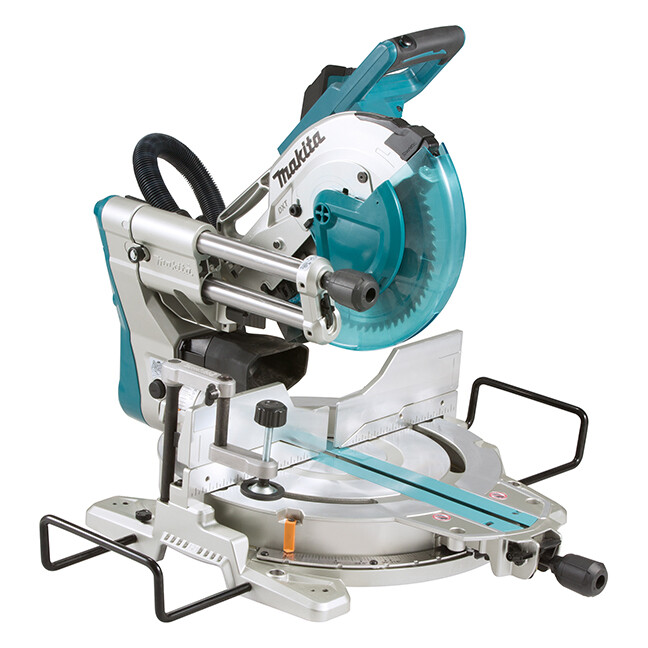
Anyone with limited workspace who still wants maximum cut capacity might want to have a look at the Makita LS1019L.
The 10-inch blade, dual compound bevel action, and laser cutline of this saw allow for precise cutting. For cutting a range of wood types, the 15-amp motor rotates at 3,200 RPMs and offers plenty of power.
This saw may be positioned closer to a wall thanks to specifically made rails that face the user. This saw is a fantastic option for a workshop or other small location because of its zero-clearance rails.
There weren’t many instances during testing where Makita missed the mark. The saw had enough cutting power, and the zero-clearance arm and its movement were superb.
Additionally, the laser aids in cutting alignment, and the dust collection is excellent. The saw’s setup was a little challenging, and despite Makita’s claims to the contrary, it’s not particularly lightweight at almost 60 pounds.
9) Metabo HPT 12-Inch Compound Miter Saw, Laser Marker System:
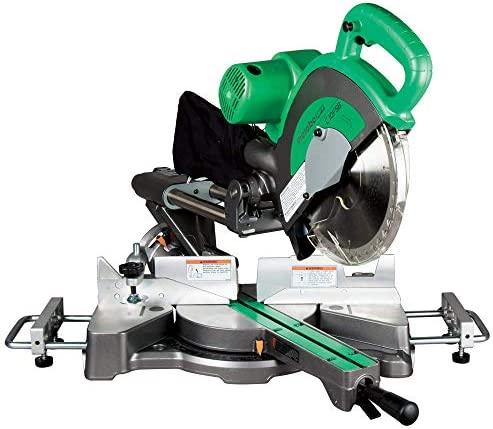
The reasonably priced Metabo HPT 12-inch mitre saw with laser guidance has a strong 15-amp motor and can cut bevels in both directions. The laser feature makes it simple to view the cutline on the board before cutting, which will cut down on errors. The Metabo also includes a rotating barrier to make cutting crown moulding easier.
The elastomer-coated handle on this full-size saw is designed to lessen vibration, hand tiredness, and hand slippage. This is a great and unexpected function on a saw with a lower price tag.
This saw surely has some advantages and disadvantages. It has the strength to cut through practically everything connected with carpentry. Another excellent feature of the laser is how quickly and easily cuts can be lined up.
Additionally, it is not overly heavy, partly because there are no slides. However, the blade on this model needed to be straightened up before it would cut accurately. Furthermore, the saw’s tilt adjustment lever is uncomfortable and difficult to use.
10) Kobalt 7-¼” Sliding Compound Mitre Saw:
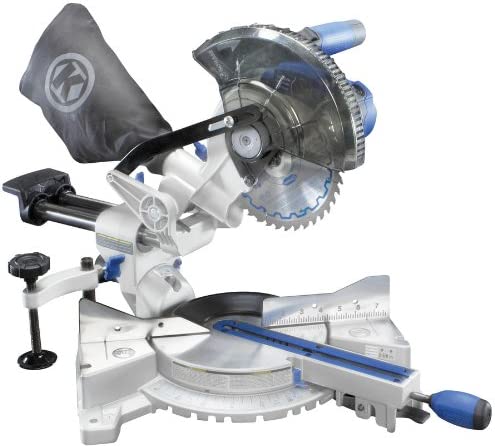
We tried numerous 714-inch saws in addition to the 10-inch and 12-inch saws, but only the Kobalt compound mitre saw made our list. The sliding rails give the blade more reach, enabling this saw to cut through lumber up to eight inches wide despite its smaller blade.
The Kobalt weighs less than 30 pounds and is still small and lightweight even though it can cut through wood that typically needs a 12-inch mitre saw. This implies that compared to those bigger saws, it is far more portable.
However, we did observe that the blade doesn’t retract all the way enough when pushing the saw back, leaving a tiny space at the very rear of your piece of wood that isn’t cut.
This saw has a dust collector that essentially does nothing. But if you connect a vacuum to the port, it becomes quite efficient. This saw also comes with a laser guide, but we couldn’t use it because it was unreliable. But the uneven cutting deck was our main complaint. It was tough to cut trim uniformly because of the 1/8-inch difference in our table’s sections.
Buying Guide: what to look for when shopping for the best miter saw?
We struggled to choose just ten fantastic mitre saws because there were so many great models available. Each of them comes with unique features, distinct blade sizes, and wildly different price tags.
However, how can you choose the ideal saw for you? This concise buyer’s guide can assist you in picking through the advertising to identify the features and functionality you require if you’re having trouble choosing between them.
Blade Size:
The size of the blade is one of the features that distinguish some of these saws from others. The smallest and largest blades on this list each measure 714 inches. Saws with a 10-inch blade fall between these two sizes. However, just because a saw has a 12-inch blade doesn’t mean it can cut lumber that is 12-inches broad.
The majority of 12-inch saws can cut through a 28, while others can only handle a 26. Smaller blades inherently have a shorter reach, thus, unless the saw has moving rails, a 10-inch blade will typically only be able to cut through a 26.
Thicker material can also be sliced with a larger blade, but this also depends on how high the blade is lifted. A saw can only cut through a certain amount of standing height.
This is crucial for trim work, as you might need to stand up a baseboard vertically to cut the mitred end. The maximum cut height of some saws is pitiful, slightly over three inches.
If you’re going to be cutting thick pieces of wood or massive trim, you should buy a saw with a large maximum cut depth because others can cut parts that are over six inches thick.
Sliding Rails:
Although it impacts what size of wood you can cut, the blade size is not the sole consideration. Some saws have a rail system that enables the blade to move forward and backwards, expanding the amount of lumber that may be cut. You can cut incredibly wide parts with your mitre saw since some of the better 12-inch models with moving rails can produce cuts that are 16 inches long.
With a sliding rail mechanism, even a little blade such as a 714-inch can cut through 28. What makes a sliding 714-inch saw superior to a 12-inch saw with the same cut length? Size, weight, and portability are a few of the factors.
Power source:
You have two options for the power source when choosing a mitre saw: batteries or AC current.
Most mitre saws are corded power instruments that use the AC energy in your home. 10-amp, 12-amp, and 15-amp motors are the most popular sizes.
The lesser powers are adequate for mild, infrequent usage, but if you plan to use your mitre saw frequently, cut through large or thick pieces of wood, or use it for a long time, you’ll probably be happiest with a 15-amp motor.
A 20-volt battery is typically used to power cordless mitre saws. These tools have the benefit of being portable, so you don’t have to worry about an electrical outlet or a cord getting in the way. They are less powerful than their corded counterparts, so you’ll need to monitor the battery’s remaining life to avoid running out of power in the middle of a project.
Contractor Advisory creator Andrew Wilson, a home improvement expert, adds, “One of the biggest risks with corded tools is the cable itself. If the cord is damaged in any manner, it may not only provide a trip risk but also present an electrical one. Before each usage, you should inspect the cord for fractures or fraying.
Most mitre saws, whether corded or cordless, have a maximum unloaded speed of between 2,500 and 5,000 rpm.
Type:
There are several different varieties of mitre saws, based on the cuts and angles they can achieve. All mitre saws can perform a mitre cut, which is an angled cut across the width of the board, as the name implies, as well as a crosscut, which is a straightforward cut across the board.
However, some mitre saws also have the ability to perform bevel cuts, which are angled cuts that produce something similar to an “overhang” at the cut edge. There are five different types of power mitre saws.
- Basic: The saw does not tilt for bevelled cuts; it only cuts mitres and crosscuts.
- Single Compound: The simplest compound mitre saws make crosscuts, mitres, and bevel cuts by tilting to the left. Due to the board’s one-way tilt, you will need to flip it over in order to bevel it in the opposite direction.
- Dual Compound: This instrument cuts mitres, crosscuts, and bevels just like a single compound mitre saw, but it can tilt in both directions, making it a far more practical option if you need to cut a lot of bevels.
- Compound Sliding: You can cut longer boards with extended rails with these single compound mitre saws.
- Dual compound sliding mitre saw: The most flexible option, dual compound sliding mitre saws can be used to do crosscuts, mitre cuts, and bevel cuts in either direction even on longer boards.
Bottom Line:
The BOSCH GCM12SD 15 Amp 12 Inch Corded Dual-Bevel Sliding Glide Miter Saw slide motion and strong motor make it a good all-around saw for those seeking one.
The Metabo HTP C10FCGS 10″ Compound Miter Saw’s simplicity, power, and precision can be sufficient if all the bells and whistles aren’t required.
If You are looking for best budget miter saw than you can buy DEWALT 12″ DWS715 Miter Saw. DWS715 is a powerful 12-inch mitre saw with a 15-amp motor that can cut through materials up to five inches thick and eight inches broad.
We hope that after reading the guide now you have a clear understanding of what to look for when buying the best miter saw.
FAQs
Which is the best miter saw?
With the movable arm included with the Bosch Power Tools GCM12SD 12-inch miter saw, users may cut boards up to 14 inches wide. The saw can steady boards up to 40 inches long and can cut compound angles in both directions. It also comes with pull-out material supports on both sides.
The Bosch miter saw’s clear saw guard is made to not block the user’s vision of the cut at any point throughout the cutting operation.
Do I really need a dual mitre saw?
You may cut precisely and uniformly on both sides of your object using a double-bevel mitre saw. Also, it quickens and simplifies the task because even on longer workpieces, you can make repeating cuts more quickly. A twin bevel mitre saw will increase productivity and efficiency for contractors or passionate hobbyists.
What is the best mitre saw for DIY?
With a direct-drive engine that won’t slow things down or slip even when the going gets rough, this 10-inch, 15-amp compound mitre saw handles crosscuts, rip cuts, bevels, and mitres with ease.
The maximum speed of this saw is 4,600 rpm, and electronic speed control maintains the speed even when it is fully loaded. This mitre saw is good for DIY.
What should you never cut with a mitre saw?
8 items listed below should never be cut with a mitre saw:
1. Ferrous substances.
2. Ceramic tiles.
3. Glass.
4. Glass.
5. Stone.
6. Batteries.
7. Greenwood.
8. Electronic gadgets.
Related Posts:
